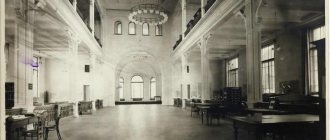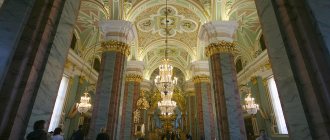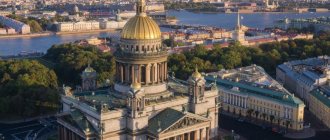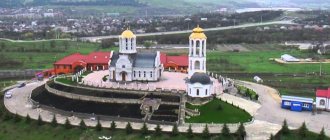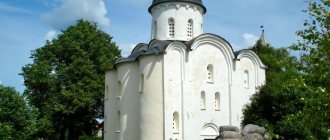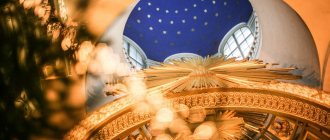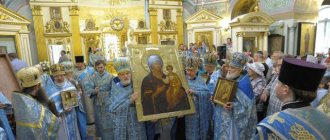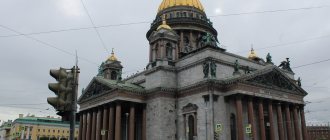| St. Petersburg St. George Church on Srednyaya Rogatka, May 7, 2007. Photo by Irina Andreeva, from the site sobory.ru |
St. Petersburg Church in the name of the Great Martyr George the Victorious on Srednyaya Rogatka,
St. Petersburg Diocese
- Throne: martyr. St. George the Victorious
- Address: Russia, 196158, St. Petersburg, Moskovskoe highway, 3
- Tel.
- On the map: Yandex.Map, Google map
The first stone church built in St. Petersburg after 1917.
The construction of the temple was carried out by the Orthodox parish of the Church of St. Sergius of Radonezh on Srednyaya Rogatka with voluntary donations from townspeople, large donors and part of local taxes.
Initially it was planned to build a stone chapel
in the name of the Holy Great Martyr George the Victorious in memory of the victims of the Great Patriotic War, on its 50th anniversary. The place for it was not chosen by chance: during the war, the second line of defense of Leningrad passed here, in addition, nearby is Victory Square with a monument to the heroes of the city’s defense.
In September 1992, architects S.V. Lyubimov and P.L. Zykov from the architectural and restoration department of the State Hermitage drew up a preliminary design for a small stone chapel. The style of the chapel combined elements of traditional Northern Russian church architecture (planned-volume composition) and architecture of the St. Petersburg period (spire, porch-portico, rusticated cladding). The character of St. Petersburg architecture was also taken into account in the design of the building’s facades. The chapel was supposed to stand in the park and have an area of 180 square meters. m. A small dome was crowned with a 21-meter high spire, made of wood and covered with copper. The project, although it was executed with taste, was not distinguished by its scale and monumentality.
On May 6, 1993, on the day of St. George the Victorious, with the blessing of Metropolitan John of St. Petersburg and Ladoga, Orthodox believers erected a cross, marking the beginning of construction of the chapel.
In preparation for construction, it turned out that the initial project needed some modification, which was undertaken by the architectural workshop under the leadership of E. F. Shapovalova. It was decided to erect the building on an embankment of one and a half meters and move it to the west, closer to the park pond. The hill gave the building greater monumentality, which was also facilitated by an increase in the height of the spire by 15 meters and an increase in volume by 20%. Although the layout and facade design were not changed, the overall impression of the building became completely different - it no longer looked like a chapel, but like a small temple. Therefore, since the end of 1993, the construction site began to be called a temple
Holy Great Martyr George the Victorious.
On May 6, 1994, with the participation of more than three thousand St. Petersburg residents, the rite of consecration of the land for the memorial temple was performed. For 40 minutes, everyone present could observe in the blue spring sky a large cross formed by two white clouds intersecting each other.
On November 16 of the same year, the ceremonial laying of the church was performed. Capsules with earth, specially brought from the hero cities, from the sites of the largest battles of the Second World War and from the city’s siege cemeteries, were lowered into the base of the building. Thus, the temple has become for many a place of prayer for those whose graves are unknown and whose ashes have nowhere to pray, according to the tradition of Russian fraternal memorial churches.
The white stone church with a tented belfry was consecrated on May 6, 1995 by Archpriest Vladimir Fomenko (+ 2009 [1]).
By the beginning of 1996, work was completed on decorating the interior, lining the exterior walls with white stone, and installing exterior mosaics depicting holy warriors. The iconostasis of the temple was carved from five types of wood by carver V. A. Mironik. Following ancient samples and canons, artist Sergei Khaigora painted 29 images for him. Two bronze chandeliers were purchased from private individuals, and the necessary utensils and vestments for worship were purchased from the workshops of the Patriarchate.
The temple is assigned to the parish of St. Sergius of Radonezh on Srednyaya Rogatka.
Archpastors
Before talking about the archpastors of the St. Petersburg Metropolis, it is necessary to determine the significance of this position in Orthodoxy.
Important! Archpastors are the primates of the diocesan community and holders of the highest sacred degree.
Now the archpastor of the St. Petersburg Metropolis is Metropolitan Barsanuphius. The Metropolitan began his spiritual journey as a novice at the Trinity-Sergius Lavra. There he took monastic vows under the name Barsanuphius, lived in the monastery and studied at the Moscow Theological Academy. He was elevated to the rank of archbishop in 2001.
Metropolitan of St. Petersburg and Ladoga Barsanuphius
Barsanuphius was appointed Metropolitan of St. Petersburg in 2014. Under the new metropolitan, the diocese began to actively develop, the number of parishes and clergy increased, and the number of parishioners increased. It was Archpastor Barsanuphius who achieved the transfer of St. Isaac's Cathedral under the jurisdiction of the Russian Orthodox Church.
The bishops of the metropolis today are:
- Bishop of Tikhvin Mstislav;
- Bishop of Gatchina Mitrofan;
- Bishop of Vyborg Ignatius.
Vicar bishops of the St. Petersburg diocese:
- Bishop of Kronstadt Nazariy;
- Bishop of Peterhof Silouan.
Russian Orthodox Church
Part of the St. Petersburg Metropolitanate
Before the establishment of the diocese in 1742, there was the St. Petersburg Synodal Region, which included some parts of the Novgorod and Karelian dioceses and the territory conquered from the Swedes. At the end of the 17th - beginning of the 18th centuries. the territory of the future diocese was under the jurisdiction of the Novgorod and Pskov bishops. Part of Ingermanland (Synodal Region) was under the jurisdiction of the Holy Synod.
The St. Petersburg diocese was established on September 1 (12), 1742. Since 1745 it has been an archdiocese. January 1 (12), 1775 merged with the Novgorod diocese. October 16 (27), 1799 The Novgorod diocese was separated from St. Petersburg. From December 19 (31), 1801, the St. Petersburg bishop was ordered to be called “and Novgorod”. On March 26 (April 7), 1818, Novgorod was again separated from the diocese. Three months later, Novgorod was returned to the jurisdiction of the St. Petersburg Metropolitan. In 1865, the parishes of the Estonian province were separated from the diocese. From October 18 (30), 1892, the department began to be called St. Petersburg and Ladoga.
By the decision of the Holy Synod of March 16, 2012 (journal No. 19), the Lodeynopolsky Vicariate was formed within the Lodeynopolsky and Podporozhye deaneries of the St. Petersburg diocese.
By the decision of the Holy Synod of March 12, 2013 (journal No. 16), the Vyborg, Gatchina and Tikhvin dioceses were separated from the diocese. The St. Petersburg diocese is included in the St. Petersburg Metropolis.
Diocese today (as of January 1, 2021)
Deaneries and deaneries
- Admiralteyskoe - Archpriest Pavel Feer
- Vasileostrovskoe - Archpriest Viktor Moskovsky
- Vyborg - Archpriest Alexander Budnikov
- Kalinin district, social deanery - Archpriest Nikolai Bryndin
- Kirov District - Archpriest Valery Dorokhov
- Kolpino District - Archpriest Alexander Selivanov
- Krasnogvardeyskoe, deanery of churches in universities - Archpriest Pyotr Mukhin
- Krasnoselsky district - Archpriest Mikhail Podoley
- Kronstadt district, military deanery - Archimandrite Alexy (Ganzhin)
- Resort District - Archpriest Vyacheslav Nikitin
- Moscow district - Archpriest Alexy Krylov
- Nevsky District - Archpriest Alexy Sklyarov
- Petrograd district - Archpriest Vladimir Sorokin
- Petrodvorets District - Archpriest Mikhail Teryushov
- Primorsky district - Archpriest Ippolit Kovalsky
- Pushkin District - Archpriest Gennady Zverev
- Frunzensky district - Archpriest Alexy Isaev
- Central District - Archpriest Sergiy Kuksevich
- Deanery of the monasteries - Bishop Nazariy of Kronstadt
- Deanery of prison churches - Archpriest Oleg Skomorokh
Temples not included in the deanery:
- Kazan Cathedral;
- RO "The Bishop's Compound of the Church of the Annunciation of the Blessed Virgin Mary in St. Petersburg of the St. Petersburg Diocese of the Russian Orthodox Church (Moscow Patriarchate)";
- RO "The Bishop's Compound of the Church of the Holy Trinity on Oktyabrskaya Embankment in St. Petersburg of the St. Petersburg Diocese of the Russian Orthodox Church (Moscow Patriarchate)";
- temple in honor of St. blgv. led book Alexander Nevsky in the Constitutional Court of the Russian Federation;
- Church of the Holy Fathers of the Seven Ecumenical Councils in the Synod building;
- temple in honor of St. ap. and Evangelist John the Theologian at the St. Petersburg Theological Academy;
- Church in honor of the Dormition of the Blessed Virgin Mary at the St. Petersburg Theological Academy;
- Church of the Twelve Apostles of St. Petersburg Theological Academy;
- Church of Seraphim (Chichagov) at the Diocesan courses of religious education.
Monasteries
men's:
- Alexander Nevsky Lavra 191167, St. Petersburg, river embankment. Monastyrki, 1; tel. (reception, office); fax (reception), 710-20-40 (press service); e-mail (reception), [email protected] (office), (press service); website lavra.spb.ru rector - Metropolitan of St. Petersburg and Ladoga Barsanuphius; vicar - Bishop Nazariy of Kronstadt
- Trinity-Sergiev Primorskaya Hermitage 198515, St. Petersburg, Strelna, Petersburg highway, 15; tel. (passage), 647-07-45 (bookstore); e-mail; website pustin.spb.ru rector - Archimandrite Nikolai (Paramonov)
women's:
- Voskresensky Novodevichy 196084, St. Petersburg, Moskovsky Avenue, 100; tel. (812) 252-11-66 (office), (pilgrim’s house); (812) 369-30-98 (monastery shop), (publishing house); e-mail; website www.novodev.spb.ru abbess - Abbess Sofia (Silina)
- Konstantino-Eleninsky 188839, Leningrad region, Vyborg district, village. Leninskoye, st. Sovetskaya, 44; tel., 343-67-89; email konst [email protected] abbess - abbess Hilarion (Feoktistova)
The total number of farmsteads is 3, hermitages are 1.
There are 257 parishes, 189 assigned churches (including those under construction), 26 monastery churches, 86 chapels, 15 prayer rooms.
There are four bishops serving in the diocese, one is a retired bishop. There are 782 full-time clergy, including:
- priests - 607
- deacons - 175.
Educational establishments
- St. Petersburg Orthodox Theological Academy and Seminary 191167, St. Petersburg, Obvodny Canal embankment, 17; tel (rector), 717-33-51 (office), 717-86-63 (assistant to the vice-rector on duty), 717-32-62 (vice-rector for academic affairs), 717-86-08 (secretary of the council); fax, 717-86-07; e-mail; website spbda.ru
- Russian Christian Humanitarian Academy 191023, St. Petersburg, Fontanka River embankment, 15; tel. (812) 314-35-21 (admissions committee); Fax; email [email protected] ; website rhga.ru
Diocesan media
- Official website of the St. Petersburg Metropolitanate https://mitropolia.spb.ru
- Diocesan magazine “Living Water. St. Petersburg Church Bulletin" https://aquaviva.ru
- Diocesan radio station “Grad Petrov” https://grad-petrov.ru
- TV project “Slovo” on the TV channel “St. Petersburg” https://www.slovotv.ru
- website of the diocesan department for prison ministry https://ots-spb.cerkov.ru
***
Report by Metropolitan Barsanuphius of St. Petersburg and Ladoga at the diocesan meeting of the St. Petersburg diocese on December 15, 2014.
Report by Metropolitan Barsanuphius of St. Petersburg and Ladoga at the diocesan meeting of the St. Petersburg diocese on December 12, 2017.
Feodorovsky Cathedral in St. Petersburg
Church of the Assumption of the Blessed Virgin Mary of the St. Petersburg Metochion of Optina Hermitage
Temples and monasteries
The following monasteries now remain under the subordination of Metropolitan Barsanuphius:
- Alexander Nevsky Lavra;
- Resurrection Novodevichy Convent;
- Holy Trinity Hermitage;
- Staraya Ladoga Holy Dormition Monastery;
- Staraya Ladoga Nikolsky Monastery;
- Konstantino-Eleninsky Monastery.
Church of the Savior on Spilled Blood in St. Petersburg
In total, there are 18 cathedrals, 345 churches and 86 chapels on the territory of the metropolitan area.
Diocesan departments
The church is involved in various spheres of life; charitable activities and social work are especially well developed. For better communication with society, special diocesan departments are created within one church-administrative region that regulate this or that area of activity.
Church Charity Department
The department's leadership, clergy and parishioners provide assistance to people who find themselves in difficult life situations. As part of their charitable activities, priests and parishioners help the seriously ill, children from disadvantaged families, and orphans.
Particular attention is paid to the fight against alcohol and drug addiction. Priests work with those who have decided to get rid of addictions. Charitable funds are opened at churches to help those in need.
Youth Affairs Department
The Church pays a lot of attention to the spiritual education of the younger generation. Representatives of the diocese organize many events where they talk about family relationships, universal human values, and Christian morality in the life of a young man. The heads of the department organize youth forums and symposiums. On the basis of parishes there are sports and creative clubs for young people.
Smolny Cathedral in St. Petersburg
Department for Church and Society Relations
Representatives of this department solve a wide variety of problems: organize religious processions, exhibitions, participate in religious discussions, take part in youth forums, and organize charity concerts.
Department of Religious Education
The first thing that comes to mind when we mention church education is Sunday school. But in addition to Sunday schools for children and adults, theological courses are held in the parishes, seminars and lectures are held, and advanced training courses for clergy are held.
Shrines of the Metropolis
- In the Alexander Nevsky Lavra there is an icon of the Mother of God brought from Mount Athos. Also, in special icon cases in the Lavra churches, the relics of the Kiev-Pechersk saints, Innocent of Irkutsk, and Fyodor of Novgorod are kept. The Lavra itself is considered one of the main Orthodox monasteries, a center for the spread of Christian culture, and an object of priceless cultural heritage.
- The Kazan Icon of the Mother of God, especially revered in Russia and throughout the world, occupies a place of honor in the iconostasis of the Kazan Cathedral. This image is inextricably linked with legends about the intercession and mercy of the Mother of God, which she repeatedly shows to our people.
- The name of Xenia of St. Petersburg is known to every Orthodox Christian. The chapel at the Smolensk cemetery, where the relics of the Saint are buried, has become a place of pilgrimage for thousands of believers.
Chapel of Xenia of Petersburg in St. Petersburg - A special icon of St. Nicholas is kept in the Church of St. Nicholas the Wonderworker. The same church houses a unique icon of the Holy Trinity.
St. Petersburg and Ladoga Diocese
Historically, the territory in church-canonical terms was under the jurisdiction of the bishops of Novgorod - until the beginning of the 18th century.
Upon the founding of St. Petersburg, before the establishment of a separate diocese, there existed the St. Petersburg Synodal Region, governed by the Holy Synod through specially appointed persons. The “Tiunskaya Izba” (office) located under the Holy Synod was in charge of the small territory of “Ingermanland” under the name of the Synodal Region.”
The diocese was established on September 1 (12), 1742 under the Archbishop of Velikonovgorod and Velikolutsk Ambrose (Yushkevich) (1740-1745) - under the administration of Bishop Niim (Srebnitsky).
After January 1 (12), 1775 and until October 18 (30), 1892, the territory was usually governed together with the Velikonovgorod diocese: the ruling bishop after June 25 (July 7), 1818 was usually titled “Novgorod, St. Petersburg, Estland and Finland, Holy Trinity Alexander Nevsky Lavra, sacred archimandrite.” Since 1865, due to the annexation of the Estonian province to the Riga diocese, the title was shortened by omitting the word “Estonian”.
In the summer of 1923, out of 123 Petrograd churches, 113 were under the jurisdiction of the “renovationist” diocese[1] under the control of the renovationist Metropolitan of Petrograd Artemy (Ilyinsky). In October of the same year, upon the arrival of the newly appointed “Old Church” Bishop Manuel (Lemeshevsky) in Petrograd, the relationship between the two opposing “orientations” changed significantly in favor of the “Old Church”, although the positions of the “Renovationists” in Leningrad remained very strong until 1943.
At the end of December 1927, due to the rejection of the “Declaration” of Metropolitan Sergius (Stragorodsky) by a significant part of the “Old Church”, as well as due to dissatisfaction with the removal from the Leningrad see of the previously appointed ruling bishop, Metropolitan Joseph (Petrovykh), a significant part of the diocese, led by the vicar Bishop Dimitri (Lyubimov) announced “On the break with Metropolitan Sergius” (Act of December 26, 1927, handed to Bishop Nikolai (Yarushevich)), after which Vicar Nikolai (Yarushevich) was appointed temporary administrator of the diocese. At the end of February 1928, Metropolitan Sergius appointed Metropolitan Seraphim (Chichagov) to the Leningrad See, who, with the assistance of Bishop Manuel (Lemeshevsky), who arrived in the spring of the same year, managed to stabilize the situation in the diocese.
By the beginning of World War II (September 1, 1939), the Leningrad diocese, along with the Moscow diocese, remained one of two dioceses of the Moscow Patriarchate within the USSR that retained a ruling bishop. The number of active parishes in it has decreased to one and a half dozen. If at the beginning of 1937, on the eve of the Great Terror, 249 parishes of the Moscow Patriarchate operated in the modern territory of the Leningrad region[2], then by the summer of 1941 there were 16 churches functioning there. The possibility of reviving churches was widely realized by believers in the occupied areas of the region, from August 1941 to the fall of 1943.
On March 12, 2013, the Vyborg, Gatchina and Tikhvin dioceses were separated from the territory of the diocese, which (together with St. Petersburg) became part of the newly formed St. Petersburg Metropolitanate[3].
Ruling bishops and their titles
Main article: Metropolitan of St. Petersburg and Ladoga
Educational establishments
The St. Petersburg Theological Academy operates on the territory of the metropolis. It was opened during the reign of Peter the Great and continues to operate to this day. The main goal of the academy is the professional training of Church ministers. The Academy prepares clergy who are capable of leading parishes, conducting divine services, and teaching in academies and seminaries.
Important! The St. Petersburg Theological Seminary prepares clergy who will later conduct their activities in parish churches.
The theological schools of the metropolis also train conductors of church choirs, where, along with specialized musical education, students receive the basics of theological knowledge.
Metropolitan of St. Petersburg and Ladoga - Barsanuphius (Anatoly Sudakov)
Barsanuphius, Metropolitan of St. Petersburg and Ladoga, Administrator of the Moscow Patriarchate
He was born on June 3, 1955 in the village of Malinovka, Saratov region, into a large peasant family. His mother, Antonina Leontievna, distinguished by her particular piety, gave him an initial religious education.
Her personal example and the example of the believers with whom the future bishop had to see and communicate, helped his faith grow and strengthen.
Malinovka village. Metropolitan Barsanuphius was born here
Returning from the army, he worked as an altar boy in the St. Michael the Archangel Cathedral in the city of Serdobsk. Here he met Archimandrite Modest, in the schema of Michael, who, with his mentoring words and his life example, determined Anatoly’s further choice in church service - monasticism.
The future bishop decides to enter the Moscow Theological Academy. He completed it successfully: in three years instead of four.
In March 1978, he took monastic vows under Archimandrite Jerome (Zinoviev) and was given the name Barsanuphius.
The viceroy of the Lavra is Archimandrite Jerome. He tonsured Alexander Sudakov into monasticism with the name Barsanuphius, Metropolitan of St. Petersburg and Ladoga
In April 1978, he was ordained to the rank of hierodeacon, and just eight months later - to the rank of hieromonk. He was elevated to the rank of abbot in 1982.
In 1982 - 1986 While studying at the MDA, he defended his PhD thesis on the history of Mount Athos.
Metropolitan Barsanuphius studied at the Moscow Theological Academy
From September 1986 to June 1988 he was the rector of the Kazan Church in the city of Kuznetsk, and for the next two and a half years he was the rector of the Assumption Cathedral in the city of Penza, secretary of the Penza diocesan administration.
In 1987, Barsanuphius was elevated to the rank of archimandrite. And just four years later he was already appointed archbishop.
Since December 25, 2009 - Administrator of the Moscow Patriarchate.
From May to October 2011 he temporarily ruled the Ardatov diocese. He was then appointed head of the newly formed Mordovian Metropolis, and a year later he was confirmed as rector of the St. John the Theologian Monastery, located in the Republic of Mordovia.
On March 19, 2014, Metropolitan Barsanuphius was appointed head of the St. Petersburg Metropolis, a permanent member of the Holy Synod. Also, he retained the position of manager of the affairs of the Moscow Patriarchate.
